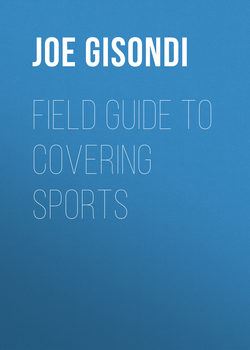Читать книгу Field Guide to Covering Sports - Joe Gisondi - Страница 45
На сайте Литреса книга снята с продажи.
Write
ОглавлениеStart with something the reader doesn’t know, says Glenn Stout, and then start teaching your audience. In “Elegy of a Race Car Driver,” for example, Markovich begins by revealing Dick Trickle’s final conversation recorded when he called a 911 operator before committing suicide.
Then, look for potential themes. Dave Sheinin, in “A Wonderful Life,” equates the instinctual way that Dusty Baker cooks collard greens to the Nationals manager’s approach to guiding a baseball team.
▸ For longer pieces, such as the 3,000-plus word “A Wonderful Life,” Sheinin prefers to create multiple sections, which essentially serve as mini-chapters. This enables a writer to more easily dive into multiple scenes and topics. The start and end of a story are most important, says Sheinin, but these other sections are equally important, enabling a writer to move toward a conclusion. “I tend to write top to bottom and tend to know the ending,” Sheinin says, “and then I try to get there.” Everything in the middle, he adds, is a means to this end.
▸ Jenkins put more emphasis on a feature’s opening paragraphs: “As long as I have a beginning, everything else will come.” Processes change among writers.
▸ Before you write, reduce your story to one or two sentences. If you have difficulty doing this, you’ll probably struggle to organize and to structure the story. Some writers, though, prefer to write more organically, letting ideas grow along the way—a method that can be both exciting and frustrating, depending on your level of writing and amount of research. Even if you use this second approach, go back and determine if you included a sentence or two that can serve as a nut graf. If not, write a few sentences and determine how this affects your story. Don’t be afraid to completely revamp, revise, move, or delete large chunks of the story. In fact, it would be shocking if you did not make such changes.
▸ Explain everything so readers won’t constantly have to look for clarification. So learn everything you can about the physics of a knuckleball, for example, before you write about this pitch’s sometimes unpredictable, fluttering movement. If you send readers to search engines, they probably won’t come back. Says Stout: “The temptation for readers to go to Google is there 100 percent of the time.”
▸ Write about places where most fans or other reporters rarely go. Yahoo! sportswriter Jeff Passan, for example, left the press box at Wrigley Field during Game 3 of the National League Division Series in 1985 to tell the stories of the six fans in the bleachers who caught home run balls hit by Cubs players, turning the game story into a feature story instead of a recitation of facts surrounding Chicago’s record-setting power performance in the 8–6 victory over the Cardinals.
▸ Think mobile, as in an audience reading these features on smartphones who pause at the bottom of the screen deciding whether to swipe ahead for another few paragraphs. As you revise, make sure every sentence has something that is instructive, entertaining, or newsworthy; otherwise even one small, uninteresting, poorly scripted section of a larger story can send readers headed elsewhere.
▸ Jenkins prefers not to start writing until he’s completed the reporting process, because he never knows what’s going to turn up late. He then reviews all of his notes, placing them on his desk where he decides what to include in the story.
